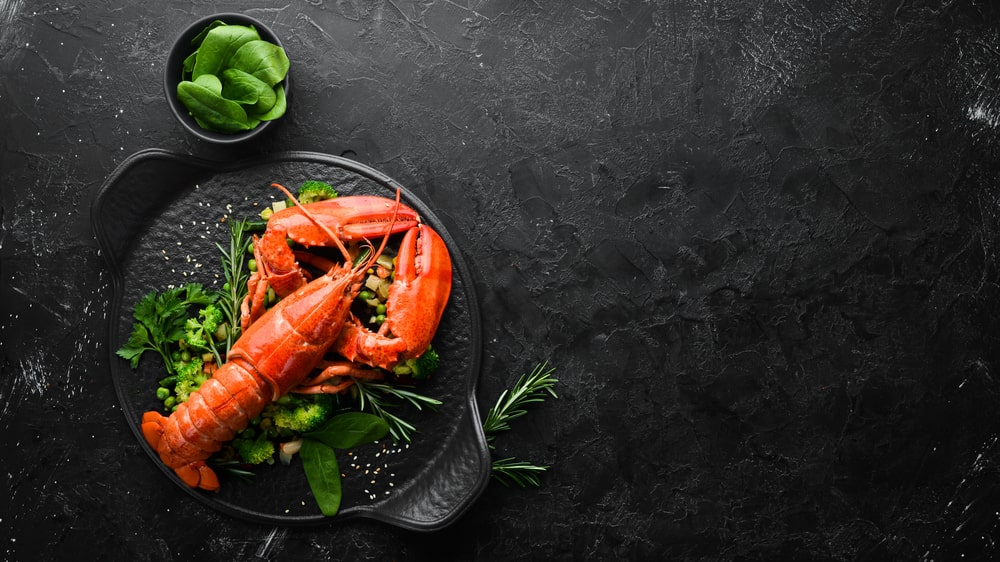Can Dogs Eat Lobster?
Yes, dogs can safely eat cooked lobster in moderation. Lobster offers several health benefits due to its nutritional content:
- Essential Nutrients: Provides zinc, phosphorus, vitamin B12, magnesium, and omega-3 fatty acids.
- Health Benefits: Promotes overall health, supports brain function, strengthens bones, and may help lower cholesterol.
Potential Risks of Feeding Lobster to Dogs:
- Pancreatitis: High-fat content in lobster could trigger pancreatitis in dogs.
- Allergies: Some dogs may be allergic to lobster, leading to skin reactions.
- Choking Hazard: Lobster shells can be a choking hazard. Never feed lobster shells to your dog.
Important Considerations:
- Moderation is Key: Only offer small amounts of lobster as an occasional treat.
- Choose Fresh Lobster: Always select fresh, unseasoned lobster.
- Remove Shells: Ensure all shells are removed before feeding lobster to your dog.
- Cook Thoroughly: Lobster should always be cooked properly to eliminate bacteria.
- Do not Feed Imitation Lobster: Processed imitation lobster meat has little nutritional value and can contain additives harmful to dogs.
How to Feed Lobster to Your Dog:
- Purchase: Choose a fresh, high-quality lobster.
- Clean: Wash the lobster thoroughly.
- Cook: Cook the lobster completely (steaming or boiling is best).
- Remove Shell: Carefully remove all shells.
- Cut into Pieces: Chop the lobster meat into small, bite-sized pieces.
How Much Lobster is Safe for Dogs?
- Small to Medium Dogs: 1-2 pieces of lobster per day is generally safe.
- Large Dogs: Up to 3 pieces of lobster per day may be okay.
- Puppies: Start with smaller amounts and monitor for any reactions.
Frequency: Feed lobster as an occasional treat, not a dietary staple.
Key Takeaways:
- Lobster can be a healthy, occasional treat for dogs when cooked and served appropriately.
- Always remove shells and prioritize your dog’s regular, balanced diet.
- Monitor your dog for any signs of digestive upset or allergic reactions after eating lobster.
- Consult your veterinarian if you have concerns about feeding lobster to your dog, especially if they have any health conditions.
Do Dogs Like the Taste of Lobster?
It is seen in most of the dogs that they find the rich, satisfying, less sweet, and fishy taste of lobster very tempting and delicious. Almost all dog breeds enjoy this fishy treat with the utmost interest.
Whereas there are some rare cases in which the dogs of some breeds refuse the intake of lobsters, in such cases, the reason might be anything like a certain disease or a particular habit of eating the same food.
It is suggested to the dog owners that they should not force the canine while it refuses to eat the meal, as forcing the canine to eat may lead to various types of discomforts in the furry friend’s stomach.
What are the Nutritious Ingredients Present in Lobsters?
The nutritious ingredients in lobsters decide how much it will be beneficial for the canine’s health. Dog owners need to know the contents of the nutritious substance in lobsters to decide if it will be beneficial for the canine.
Here is the name of the nutritious compounds present in it:
- Zinc
- Phosphorus
- Vitamin b12
- Magnesium
- Vitamin E
- Potassium
- Omega 3 fatty acids
What are the Benefits of Feeding Lobsters to the Canine?
As per research, we have obtained the information that there are several benefits that the canine gets after the consumption of lobsters for several days. Here are the benefits of lobster consumption for the canine’s health.
Improves the Overall Health
The nutritious compounds present in lobsters, like potassium and omega-three fatty acids, work for proper blood flow inside the canine’s body, which makes sure that the canine is getting a sufficient amount of nutrients for the proper functioning of the organs, thus lowering the risk of heart diseases, weight gain, and diabetes.
Healthier the Canine’s Bones
Compounds like hydroxyapatite, the most vital element of the bones of the canine, increase in amount due to the energy it gets from the absorption of calcium on its surface from the consumption of lobsters, making the canine’s bones healthier.
Lowers the Level of Cholesterol
As per research, the contents of unsaturated fats in lobsters are much lower than that of the egg. The cholesterol level in lobsters is 147 mg, whereas the level of cholesterol in eggs is 187 mg. Thus, it is to be said that the consumption of lobsters lowers the cholesterol level of the canine.
Boosts the Functioning of the Brain
The vitamins and minerals in the lobsters work to promote the functioning of the brain by strengthening the nerves directly connected to the interior part and promoting blood flow, thus boosting the brain’s functioning.
What are the Potential Threats Caused Due to the Consumption of Lobsters?
The main fact that dog owners have to notice while feeding lobsters to the canine is that although it is beneficial for the canine’s health, it can still cause some potential health risks.
So, it is better to discuss this with the vet before feeding lobsters to the canine. Here are the potential threats that the consumption of lobsters can cause.
Pancreatitis
The presence of high amounts of sodium and cholesterol in lobsters is mainly responsible for the cause of pancreatitis. Consumption of lobsters in large amounts can increase the fats in the organs like the pancreas and cause pancreatitis.
Allergies
After a few days of regular lobster consumption, the canine has started to get rashes on its skin. The reason behind this can be the allergic response of the canine’s body towards the nutritious substance of lobsters.
Thus, it is suggested that dog owners always go for feeding a small amount first to identify if the canine is allergic to it.
Choking Hazards
There is a chance of choking hazards for the canine after consuming lobster. However, this especially happens when the lobsters are given to the canine with shells, so it is suggested to the dog owners that they should always remove the shells of the lobsters before giving them to the canine.
Can Dogs Eat Lobster?
Yes, it is safe for the canines to eat lobsters, but only moderately, and maintain alternate gaps within each consumption. This is necessary because maintaining a gap will give time to the canine’s digestive system for a complete procession of the food.
Can Dogs Eat Lobster Bisque?
No, it is highly recommended by veterinarians that dog owners never feed lobster bisque to their canines.
This is because it is a thick and creamy soup that consists of a lot of fatty molecules like cheese and different types of spices, which can be toxic to the stomach of the canine and lead to gastrointestinal disorders.
Hence, it is suggested that dog owners strictly avoid feeding this delicious lobster soup to the canine.
Can Dogs Eat Lobster Tails?
Yes, it is safe for dogs to eat the lobster tail. The number of nutrients in the tail is the same as in the rest of the body parts. However, it is very important to cut it to make it easy for the canine to swallow properly.
There is a technique that most dog owners prefer when choosing fresh lobsters for their dogs. All they do is sniff the lobster and smell it.
If the tail smells fishy and pungent, the lobster is not safe anymore, whereas if it smells sweeter, it is ready to proceed.
Can Dogs Eat Lobster Shells?
No, it is not at all suggested that dog owners feed their canines the shells of the lobster. This is because, along with being hard,
It contains some toxic substances that can harm health, and its hard nature can cause excessive choking of the canines; thus, it needs to be avoided.
Can Dogs Eat Imitation Lobster Meats?
No, it is not suggested that dogs eat imitation lobster. This is because it is not the actual lobster meat. It is a mixture of processed white fish and some other additives. Feeding this to the canine does not fulfil its nutritional deficiency and even causes severe discomfort to the canine.
How Much Lobster Can a Dog Eat in a Day?
As per the research on the consumption of lobsters by the canine, it can be said that the digestive system of dogs is only capable of digesting one to three pieces of lobsters per day. If the dose is excessive, then it will harm your dog.
At least two pieces of lobster are sufficient for all types of dog breeds, but if it is in the case of a puppy or a dog of a smaller breed, then the dose should be more confined and must be limited to one piece of lobster per day.
How Often Can a Dog Eat Lobsters?
For your dog, eating lobster per day is safe, but the only thing to notice here is that the number of lobsters induced should be divided into two to three meals.
Dividing the lobsters into two to three parts will give sufficient time to the canine’s digestive system for proper digestion of the lobsters eaten. Thus, it is suggested that at least three to four hours of gap is necessary to process the lobsters properly.
What are the Proper Steps to Feed Lobsters to Your Canine?
Now, after knowing all the benefits of lobsters to the canine, it becomes very important for the dog owner to know the proper steps to feed lobsters to the canine. So that the dog gets all the benefits without getting any harm, here are the steps to follow.
Choose a Fresh Lobster
This is one of the most important steps, as choosing fresh lobster for your canine will provide all the nutritional benefits to the canine without any toxicity.
Wash it Thoroughly
A proper wash of the lobster chosen is necessary because a thorough wash will remove all the pathogenic bacteria over the surface of the shell. Thus, a thorough wash of the lobster will make it bacteria-free.
Remove the Shells
It is also one of the most important steps; the shell’s removal is necessary for making the lobster choking-resistant. All the owner has to do for this is just put a knife on one edge of the shell and scrap it off.
Chop it into Pieces.
Now that all the steps are done, the last step to follow is to chop the meat into little pieces so that it is easy for the canine to swallow it properly.
It is a must for dog owners to keep all the factors mentioned above in mind while looking for can-eat lobster to induce this healthy treat in the canine’s diet.


